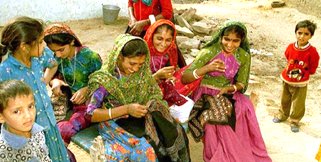
Bandhani tie and dye is found in some forms in almost all parts of the world. ‘Bandhani' is also called as ‘Bandhej' came originally from the word ‘Bandhana' (to tie). Today, most of the Bandhani produced in India is made in Kutch, Saurastra and in other neighbouring districts.
Production Process
The process of tie-dye is relatively simple, but it is very difficult and time consuming. The material to be used is folded more than a few times until reduced to a square or rectangular piece. It is spread on wooden table and desired designs are marked on it with a wooden block (An even nail block) using ‘Gheru' (Red oxide) mixed with water. Then, it is taken off the table given to a Bandhani craftsperson, who purposely allows the thumb and the finger nail to grow long so as to use them as a pair of tongs for trying the marked portions into tiny knots. The decorative designs indicated by the block are sized and skillfully tied with thread thus retaining the original colour of the material in that portion. Then, it is dyed in a light colour generally yellow. The area requiring yellow is once again tied and later dyed in red or another required dark colour. Thus, the different colours required are introduced into the materials. After the process of tying and dyeing, the cloth is washed with soft water to remove the colour impurities. Then, to remove the colour knots, the process of hitching is done. Two ends of the cloth material are caught by two persons. It is a little hitched in the open air or in the sunlight so that the knots are automatically removed and the tied parts are free. The traditional motifs used are like Sikar, Kori, Badam, Champakali, Kharek etc. Bandhani is used in main products like sarees, Punjabi dresses, cloth, skirts and shawls etc. Tie-dye Odhanis are produced in cotton, silk and georgette. Mandvi, Bhuj, Khavda, Dhamanka, Tera, Bara and Anjar are main centres of tie-dye. According to the survey of tie-dyeing held in 1961, the completion of a piece of the ‘Bandhani' takes almost eight hours. Red knots can also be removed or lightened or even eliminated by submerging the cloth in a solution of caustic soda and sodium hydrosulphite. 
The dyes of all types of Bandhani work used today are always artificial. The widespread dyes were originally thought from the ancestry of Morinda Cordifolia, in combination with an double sulphate of Aluminium and Potassium caustic for the fast (Pakka) red, Kasum from the petals of sunflowers, Carthamus Tintorius for Kutch red, Haldi from the tuber of Curcuma Domestica with Chhach for yellow and Gali, Indigo from the leaves of Indigofera Tintria for blue. Their financial records of sloping sharply with the cloths of difference of several days and strong with the simple summary are required for chemical dyes to create the result. The difficult work of collecting the dye plants and obtaining their dyes are not referenced by either of 19th Century writers but it is hardly surprising that current dyers enthusiastically took up the opportunely tinned colours that took their place.
Bandhani is done with cotton, gajji silk, fur, muslin etc. in Gujarat. The smooth weave known as gajji which was used for more costly Bandhani textiles up to the early 20th Century gives richness to the delicately worked designs which are distinctive of Gujarati tie and dye skills.

The ‘Gharcholu' designs are given to a girl by her husband at the time of their wedding. She usually arranges it over her head. It is exclusively covered during the ceremony, while she wears under the traditional white silk saree called ‘Panetar' with a red border.
According to the survey, more complicated designs in Bandhanis are finished in villages of Kutch. Many of them are sent to Jamnagar for dyeing and advertising. As stated in the survey of 1961, there were about 4000 people functioning in the tie-dye industry in Kutch mostly in Bhuj and Anjar. The leading persons in Kutch are ‘Khatris' who have expended a effective monopoly on textile production since middle aged times. It is said that the Khatris have been came from Sind.
The tie-dyed silk fabrics worn by the Khatri Muslims are completely different from the Hindus. The Hindus and the Muslims country communities normally make extensive use of Bandhani textiles, both as ‘Chunaris' and ‘skirts'. Their fairly basic linear designs are originally from Sind. The waterless areas of Northen Kutch and Banni are just like deserts and many communities describe their origins to Sind. Complex embroidered patterns are often added over the basic tie dye fabric and a practice is also seen in more difficult level both in designs and techniques among the Khatri Muslims.



 03:54 AM
03:54 AM
 nikhil
nikhil

4 ટિપ્પણી(ઓ):
Very informative post!!
Indian Sarees Online Shopping
Wedding Sarees Online
Designer Sarees Online
Traditional Sarees Online
Cotton Sarees Online
Silk Sarees Online
Online Salwar Kameez
Wedding Salwar Kameez Online
Designer Salwar Kameez Online
Party Wear Salwar Kameez Online
Cotton Salwar Kameez Online
Silk Punjabi Suits Online
Designer Kurtis online
Online Indo Western Apparel
In gujarati language
In gujarati language
10 best crypto casinos like Coin Casino & Slots
Bitcoin Casino with an awesome collection of 50+ slots and games with a 제왕 카지노 cool welcome 인카지노 bonus with no deposit required. Try your luck on our best worrione online slots
ટિપ્પણી પોસ્ટ કરો